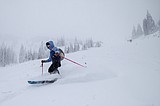Experts monitoring multiple variables ahead of wildfire season
KATE HESTON | Hagadone News Network | UPDATED 1 year, 11 months AGO
Kate Heston covers politics and natural resources for the Daily Inter Lake. She is a graduate of the University of Iowa's journalism program, previously worked as photo editor at the Daily Iowan and was a News21 fellow in Phoenix. She can be reached at [email protected] or 406-758-4459. | January 16, 2024 11:00 PM
After a historically hot and dry summer in Northwest Montana last year, experts and scientists are spending the colder months monitoring moisture levels, weather patterns, drought and other factors in anticipation of the upcoming fire season.
They’re the first to admit it’s no easy task.
“If you can tell me now if you are going to have red tomatoes or green tomatoes this summer, then I can tell you what summer will be like in terms of fire,” said Rick Connell, a fire management officer with the U.S. Forest Service.
Fire is dependent on multiple factors, a main one being moisture. You can have five feet of snow in a winter or 50 feet of snow, Connell said, but if you lose out on spring or summer rain, that is typically more indicative of what fire season will bring.
Even experiencing early summer rains does not guarantee that the moisture will stay around to mitigate dryness and fuels throughout the rest of the summer, he said. An average fire season runs July to September. Spring or early summer rains can sometimes delay the start date.
“Having those rains in June means that you won’t start early,” Connell said, “but it does not guarantee that you won't go late.”
In an El Nino year, Montana experiences, on average, drier and warmer weather.
Scientists are continuing to track the ongoing drought signature in Northwest Montana and Northern Idaho, according to Dan Borsum, a fire weather meteorologist for the Northern Rockies Predictive Services.
The weather pattern at the start of winter has slowed the drought a bit, Borsum said, as there was slightly more shower activity. However, trying to reduce drought trends at this point in the year is hard because there isn’t a ton of moisture.
“We haven't made things much worse, we certainly haven't made them much better,” Borsum said.
The current weather — with lower temperatures and more snow — makes it seem like Northwest Montana has hit a “pause button” on the drought, Borsum said. However, moisture conditions remain below normal.
“We’re leaning dry,” Borsum said. “We’re existing dry.”
But “there just aren’t strong enough signs on the future forecast right now to decide a clear cut outcome,” he cautioned.
In December 2023, just 5 inches of snowfall was recorded at the Glacier Park International Airport weather station. Kalispell normally averages 15.9 inches in December.
The current Flathead Basin snowpack is only 62% of the area’s normal snowpack at this time, according to the Natural Resources Conservation Service.
Northwest Montana is still in the early stages of the snow season, though, meaning that more precipitation could arrive to boost moisture levels. But if the snowpack depleted quickly in May — like it did last year — that could lead to extenuating circumstances.
“That isn't the weather pattern that dramatically shifts things in our favor,” Borsum said.
One way to view a snowpack is like a savings account, according to Eric Sproles, Montana State University assistant professor of snow and water resources.
When preparing for an upcoming fire season during a dry El Nino year, Sproles said it's important to keep a close eye on what is happening on the ground. For example, if water levels are low in a reservoir come spring, operators should be cautious about releasing too much.
If your savings account is getting low, you don’t want to tap into it, he said.
Recognizing that a drought is occurring, Sproles said, can help communities evaluate how to use their water in dry season.
Come April, more confident guesses might be made about the fire season, according to Connell.
It is also hard to predict how fire will affect the places immediately around the Flathead Valley. A major factor for the Flathead National Forest, Connell said, is summer lightning, which causes about 75% of the forest’s fires.
There are just a lot of factors playing into the intensity of the season that make it difficult to predict, he said.
“As much as climate and meteorology think they can tell us stuff, it’s hard to really track … There is always variability,” Connell said.
Reporter Kate Heston can be reached at [email protected] or 758-4459.
ARTICLES BY KATE HESTON

Veteran-owned mobile boat repair service anchors down in the Flathead Valley
The Kramers launched Flathead Mobile Marine to use their skills — they have decades of experience performing routine maintenance checks on a variety of boats as well as working with engines and electrical systems — and help boaters in the community.

With ski season near, resort reaches deal with staff
After 18 months of negotiations, Whitefish Mountain Resort executives and the resort’s ski patrol union are finalizing a one-year contract for the upcoming season.

Trapped in a car wreck, Woods Bay woman credits teens with saving her life
Driving home from a quilting event in Bigfork in September of last year, Carol Martin remembered that the sky was clear, the sun was shining, and she had a headache.

